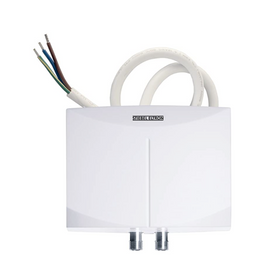
Stormwater Management at Home
Last Updated: Mar 28, 2025In theory, rainwater falling on our landscapes should be a good thing. All living things need water to survive. Roughly 40 inches of average annual rainfall is necessary to keep our crops growing, our forests healthy, and our rivers flowing. In a healthy ecosystem, heavy rains and excess snowmelt would be absorbed by a thick, nutrient-rich layer of topsoil. Topsoil acts like a sponge, soaking up water and making it available to plants. The rivers and streams would carry the excess moisture to lakes - and eventually to the ocean, where it would evaporate into clouds before eventually falling once again as rain to complete the hydrologic cycle.
Table of Contents
- What IS Stormwater?
- Why Is Stormwater Runoff a Problem?
- Sustainable Stormwater Management Starts at Home
- Porous Materials to Reduce Stormwater Runoff
- How Can Stormwater Runoff Be Reduced?
- Can You Capture Storm Water Before it Leaves Your Property?
- Bottom Line

Today, an incredible 55 percent of people live in urban areas, and the United Nations (UN) projects that to reach 68 percent by 2050. As more and more land is developed, paved surfaces cover what were once forest floors, meadows, and fields, leaving very little space for rainwater to seep back into the soil.
What IS Stormwater?
Stormwater is defined as surface water in abnormal quantity resulting from heavy falls of rain or snow. Stormwater can have adverse environmental effects, as discussed below. Every homeowner can help reduce and even eliminate some of the negative consequences of stormwater by following some of the landscaping suggestions we offer.

Why Is Stormwater Runoff a Problem?
Water is a necessary natural resource, but too much of it in one place can cause a variety of problems. The development of roads, buildings, and other hardscapes is causing growing issues with stormwater runoff, flooding our streets and homes, and polluting local drinking water, rivers, lakes, and oceans. An inch of rain may not seem like much to you, but even a small roof can collect hundreds of gallons of water from just that single inch.
To calculate your home's actual runoff volume, measure the square footage of your roof, and multiply it by 0.62 gallons (2.35 liters) to get the volume of water flowing off per inch of rainwater.

Contamination from Stormwater Runoff
While rainwater alone is relatively harmless, as stormwater runs over our urban and suburban landscapes, it picks up pollutants. Those pollutants then make their way into streams, rivers, lakes, and oceans. Not only does this negatively affect the habitat and well-being of fish and other animals, but it can also pollute our drinking water. Some of the most common pollutants from urban and suburban landscapes that stormwater can collect include:
- Pet waste that accumulates in yards and parks can be a source of bacterial pathogens and parasites.
- Automotive fluids, such as motor oil and antifreeze that leak onto driveways and road salts.
- Chemical fertilizers, herbicides, and pesticides used on lawns and gardens. Common herbicides such as Roundup contain glyphosate, which is a likely carcinogen.
- Plastic litter and pollution found on the sides of roads, which never decompose and can clog sewers.
- Soaps from washing cars.
- Heavy metals that leach from roofing and other metal surfaces.
Most people wouldn't want any of these pollutants in the water they drink. Unfortunately, about 13 percent of U.S. rivers, 18 percent of lakes, and 32 percent of estuaries are severely polluted by stormwater and are unsafe for swimming or fishing. Very few towns or cities filter or treat the stormwater before sending it back to a creek or river system. The United States Environmental Protection Agency (EPA) states, "polluted runoff is one of the greatest threats to clean water."
Most municipal water systems have a separate stormwater and sewer system. However, one study found that at least 772 US cities have combined storm and sanitary sewer systems. In these cases, heavy precipitation events can overwhelm the sewer system, and all sorts of dangerous pathogens flow directly into the local receiving waters.

Sustainable Stormwater Management Starts at Home
What can a homeowner do? Every action you take to soak up the rain and snow from your property helps to reduce runoff. Whether you live in an area that sees a lot of rain or snow or is relatively dry aside from a few storms, stormwater has to have somewhere to go.
If not properly managed, stormwater will find its own route and can lead to disastrous consequences. Rainwater and melting snow may collect around the foundation of your home, causing expensive damage and possibly flooding your basement and ground floor. Also, excess water may flood streets, septic systems, and drain fields.
Because pathogens that collect in stormwater accumulate from several different sources, individual homeowners can make a difference by reducing the pollutants that can collect on their property. Here are a variety of ideas.

Avoid Lawn Chemicals
While most homeowners want a lush, green yard, heavy doses of herbicides, pesticides, and fertilizers will get carried away by stormwater after a heavy storm. These chemicals are potentially dangerous to the health of pets and children. Instead of fertilizing with chemical inputs, consider top dressing your lawn with compost. This will deliver non-toxic nutrients to your lawn. It will also improve the quality of your soil so that your grass can naturally resist common lawn diseases while also outcompeting other weeds.

Porous Materials to Reduce Stormwater Runoff
While rainwater and snowmelt will naturally seep into the soil, homes surrounded by concrete and asphalt often provide no relief for stormwater. However, there are several solutions to maintain your hardscape and eliminate water runoff.
Instead of the traditional blacktop (which has its own health risks), consider a porous driveway material like brick, gravel, stone slabs, and geotextile materials over big sheets of concrete. Though more expensive than conventional paving, porous hardscapes are an excellent choice for driveways, walking paths, and patios and can last up to 10 years longer than traditional asphalt. They also have many added benefits. They can increase your home's property value, melt ice more quickly, and give you the option to replace pavers individually rather than repaving the entire surface. Some cities, like Minneapolis, may even provide you with credit on your water bill for managing your stormwater on-site, so it's a good idea to check with your water provider to see if you can get an additional financial benefit. Porous paver options include:
Open Pavers
Many unique hardscapes have been designed and installed with brick and stone, spaced to allow rainwater to seep into the Earth between pavers. Hundreds of options in size, shape, color, and pattern arrangement enable homeowners to create beautiful hardscapes unique to their homes.

Engineered Grass Pavers
Pre-cut rolls of hexagonal cells can be laid out quickly to create a 100% grass driveway. This allows for safe stormwater drainage while also protecting roots and soil compaction. These hardscapes safely support vehicle traffic and will last up to 60 years longer than concrete or asphalt. (Note that your driveway would have to be sloped less than 8 percent.)
Permeable Pavers (PICP)
These porous concrete bricks are installed over the aggregate stone and separated by joints/gaps filled with gravel/sand to allow rainwater to pass through. These hardscapes are safe for vehicle traffic, provide excellent traction, and reflect light for better visibility in dark and inclement weather.
How Can Stormwater Runoff Be Reduced?
Using sustainable roofing materials, installing rain gutters and downspouts, and opting for a green roof will all help to reduce stormwater runoff.
We'll look at these in-depth below.
Sustainable Roofing Materials
The rainwater that falls on your roof most likely flows down your shingles, through a gutter system, and onto your driveway before eventually making its way to the sewer. Asphalt shingled roofs can leach dangerous heavy metals such as copper, phthalates, and even lead from roofing screws and washers into waterways. When it comes time to replace your roof, consider opting for one of these more sustainable roofing options. Not only will this reduce the chemical runoff into stormwater, but it will also allow you to experiment with home rainwater catchment systems.
Rain Gutters
Properly installed rain gutters, leaders, and drains will collect water and direct it to a safe location, away from the foundation of your home.

Downspouts
Drainage from your rain gutters should be directed to natural areas where water can soak into the ground or directly into a rain barrel or cistern. Collected water can be used to water your lawn and garden, wash cars and pets, and flush toilets—all of which will reduce your water bill.

Green Roofs
Installing a green roof will allow rainwater to naturally absorb into rooftop soil and plants and safely filter runoff. A green roof will also provide the added benefits of:
- extending the life of your roof
- insulating your home
- decreasing urban heat island effect
- improving local air quality

Can You Capture Storm Water Before it Leaves Your Property?
Stormwater can be captured before leaving your property using sales, curtain drains, foundation flashing, and dry wells.
Swales
It is also possible to capture excess rainwater flowing over your property by designing a system of swales. Swales are simply on contour ditches filled in mulch or other porous, organic material. As water flows over the land, it will infiltrate these swales and filter into the ground. A series of well-designed swales placed strategically in a yard can effectively eliminate the stormwater leaving your property and entering the sewer system. Swales can help increase your land's fertility for productive landscaping designs—like rain gardens. A less expensive option, but one that can still help mitigate stormwater runoff, is to install a rain barrel at your roof's downspout.
Curtain Drains
Trenches dug around your house and filled with permeable materials (like gravel) can provide safe drainage for stormwater.
Foundation Flashing
Also known as in-ground gutters and underground roofs, these sheets of plastic are installed to run down your home's foundation and slope away to prevent water from collecting under or near the foundation.
Dry Wells
These gravel-filled areas can be installed throughout your yard and even under grass and hardscapes to store stormwater underground.

Bottom Line
There's nothing we can do to stop rain from falling or snow from melting, but every homeowner can give stormwater a safe place to stay close to home. Local governments and organizations are tasked with the responsibility of local stormwater management. But, keeping water from running off your roof and yard can go a long way to prevent flooding in your home and neighborhood and prevent polluted water from reaching drinking supplies and animals.
A sustainably-minded landscaping expert or construction professional can help you make the best choice in stormwater management solutions and complete a safe installation.
Laura Bourland
Laura grew up in the California suburbs, far removed from environmentalism, but nature always has a way. She uprooted her life in 2015, moving to the countryside of Washington to live a more sustainable and simple life on 12 acres. She and her fiancee are learning on the job as they attempt everything from gardening and natural pest control to eco-friendly building and home improvement.










